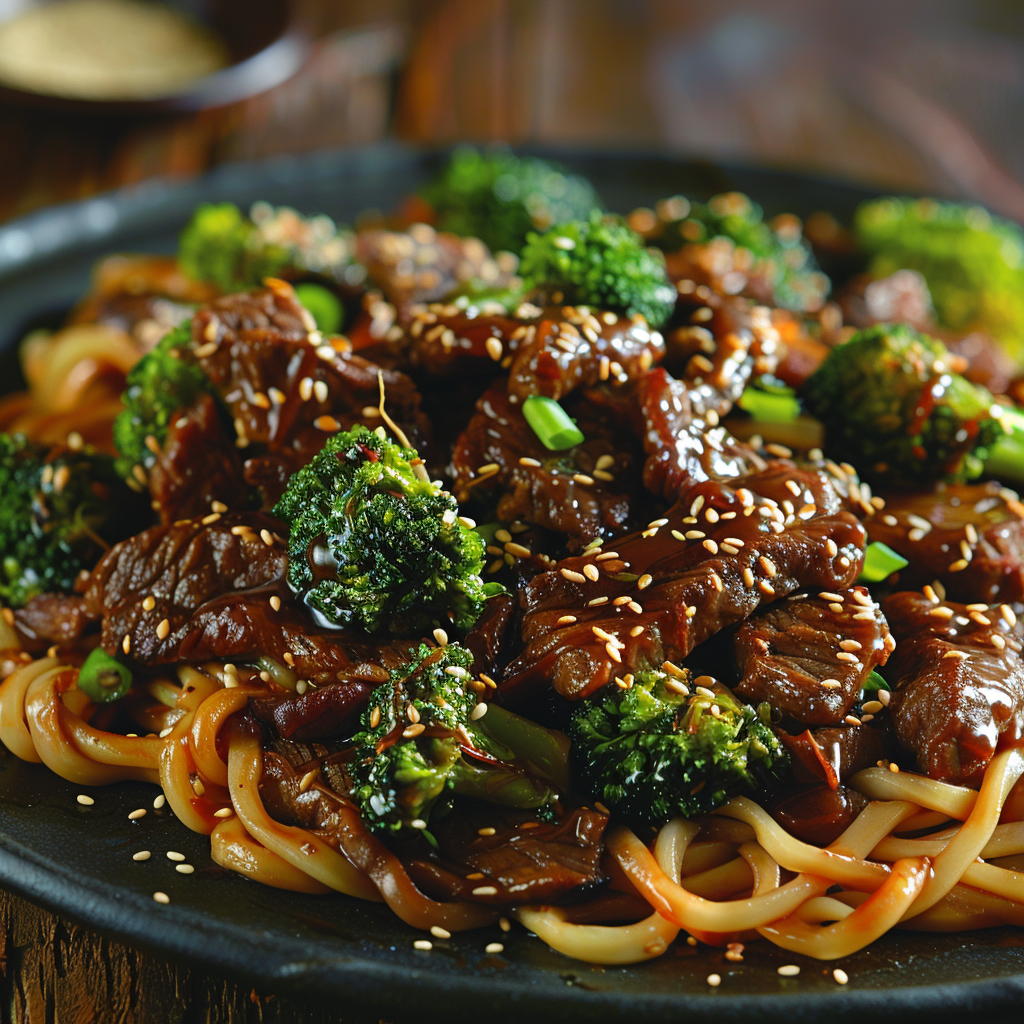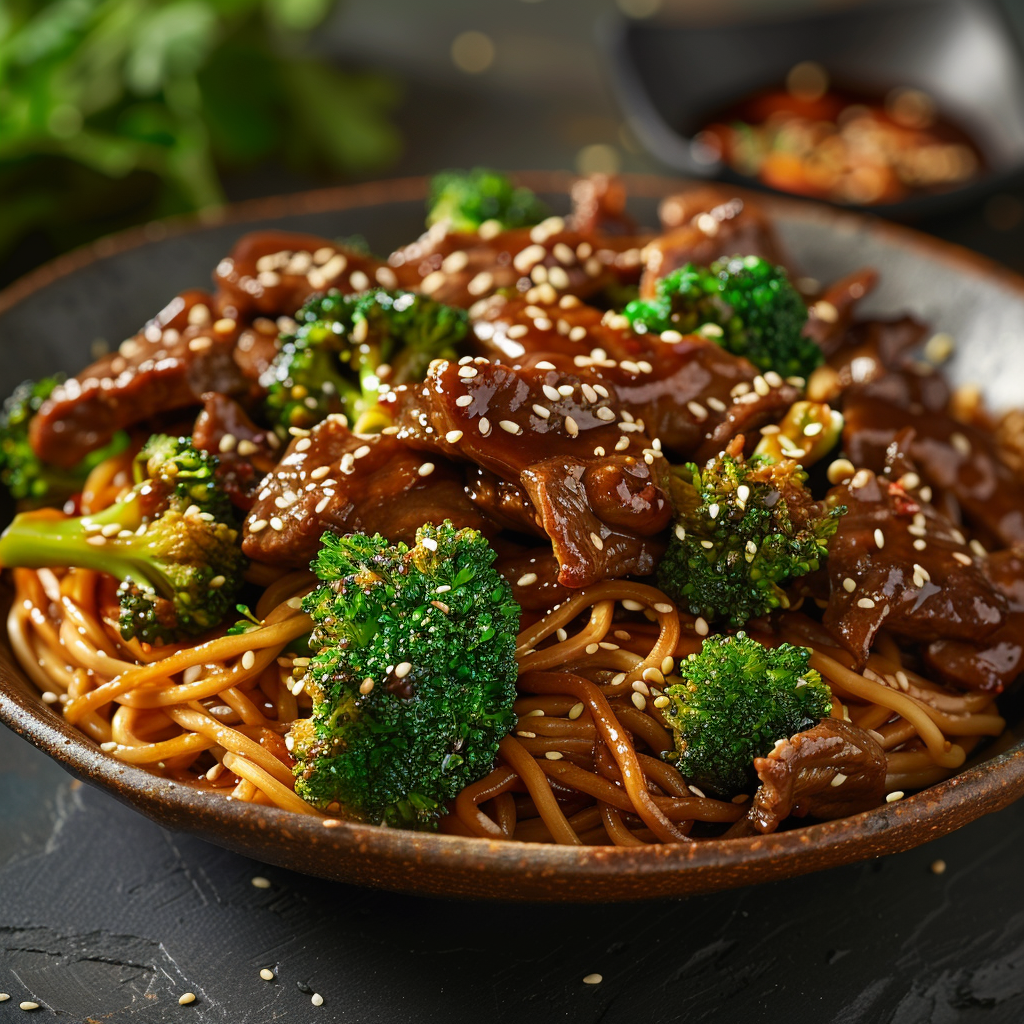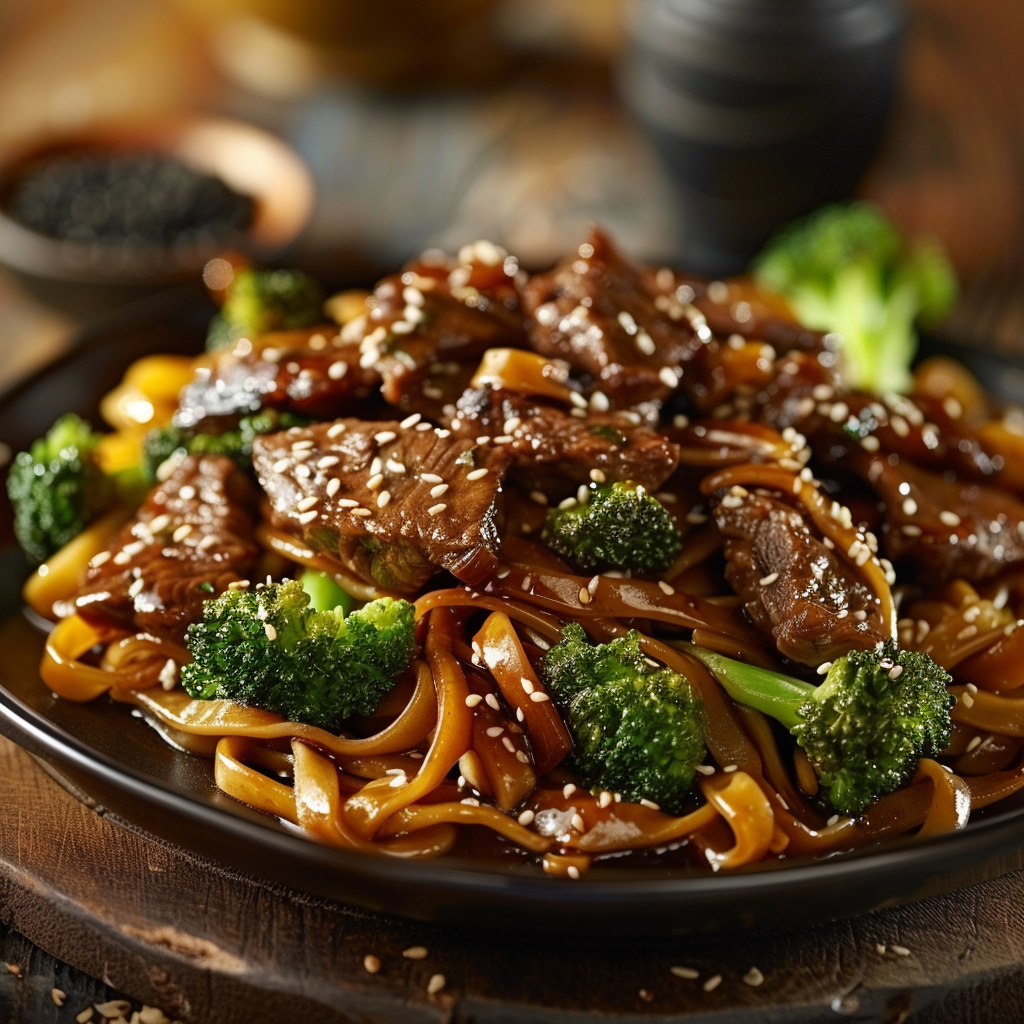Why Mongolian Beef and Noodles Will Win Your Heart
Picture this: it’s a chilly Tuesday evening, and I’m craving something comforting yet exciting. That’s when I decided to whip up my favorite mongolian beef and noodles. The rich aroma of garlic and ginger mingling with tender beef and perfectly cooked noodles had my kitchen smelling like a cozy Asian bistro. It’s not just food—it’s an experience. Whether you’re a fan of mongolian beef crispy noodles or prefer the softer texture of ramen, this dish is versatile enough to satisfy everyone. Plus, it’s so easy that even my dog, Max, could probably make it (if he had opposable thumbs).
A Little History Behind the Dish
Now, here’s a fun fact: despite its name, mongolian beef and noodles isn’t traditionally Mongolian at all. It actually originated in Taiwan as part of what we now call “Mongolian BBQ,” which has nothing to do with Mongolia itself. Go figure! The dish combines savory flavors inspired by Chinese stir-fries with a touch of sweetness from soy sauce and brown sugar. Over time, people started adding noodles to soak up all that delicious sauce. When I first tried making traditional mongolian noodles, I was blown away by how simple yet flavorful they were. My kids loved it so much they asked for seconds—and thirds!
Why You’ll Love This Recipe
Let’s talk about why this recipe deserves a spot in your weekly rotation. First off, it’s packed with bold flavors—savory, slightly sweet, and oh-so-satisfying. Second, it’s super quick to make. We’re talking 30 minutes tops, including prep time. And third? It’s customizable. Want it spicy? Add chili flakes for some spicy mongolian noodles. Craving crunch? Toss in some fried wonton strips for mongolian beef crispy noodles. No matter how you tweak it, this dish always hits the spot.
Perfect Occasions for Mongolian Beef and Noodles
This dish shines on busy weeknights when you need something hearty but don’t want to spend hours in the kitchen. It’s also perfect for dinner parties because it looks impressive without requiring fancy skills. Imagine serving a steaming plate of mongolian beef ramen alongside some spring rolls and dumplings. Your friends will think you’ve been taking secret cooking classes! Plus, if you’re wondering about mongolian beef noodles near me, why not save money and make it yourself?
Ingredients
- 1 lb flank steak, thinly sliced
- 8 oz fresh or dried noodles (egg noodles work great)
- 2 tbsp vegetable oil
- 3 cloves garlic, minced
- 1-inch piece of ginger, grated
- 1/4 cup soy sauce
- 2 tbsp brown sugar
- 1/2 tsp red pepper flakes (optional for spicy mongolian noodles)
- 1/4 cup water or beef broth
- 2 green onions, sliced (for garnish)
- Sesame seeds (optional, for garnish)
Substitution Options
- For a vegetarian twist, swap the beef for tofu or mushrooms.
- If you can’t find egg noodles, try udon or even spaghetti for mongolian ground beef noodles.
- Use coconut aminos instead of soy sauce for a gluten-free option.
- Swap brown sugar for honey or maple syrup if you’re out.
Preparation Section
Step 1: Prep Your Ingredients
Before diving into cooking, let’s get organized. Slice the flank steak against the grain—it makes the beef extra tender. Mince the garlic and grate the ginger; their fragrant oils will elevate the dish. Pro tip: Keep all your ingredients prepped and ready before turning on the stove. Trust me, once things heat up, you won’t have time to chop!
Step 2: Cook the Noodles
Bring a pot of salted water to a boil and cook the noodles according to the package instructions. Drain them and set aside. For those aiming for mongolian beef crispy noodles, fry cooked noodles briefly in hot oil until golden and crunchy. The contrast between soft and crispy textures is divine. Chef’s tip: Don’t overcook the noodles—they should still have a slight bite.
Step 3: Sear the Beef
In a large skillet or wok, heat one tablespoon of oil over medium-high heat. Add the sliced beef in batches to avoid overcrowding. Sear each side until browned but not fully cooked through. Remove the beef and set it aside. This step locks in the juices, ensuring every bite is melt-in-your-mouth goodness.
Step 4: Make the Sauce
In the same skillet, add the remaining oil along with garlic and ginger. Stir for about 30 seconds until aromatic. Pour in the soy sauce, brown sugar, water or broth, and red pepper flakes if using. Let the mixture simmer for a minute to thicken slightly. The sauce should coat the back of a spoon—rich, glossy, and irresistible.
Step 5: Combine Everything
Return the beef to the skillet and toss it in the sauce. Cook for another 2–3 minutes until the beef is fully cooked and coated in the sauce. Add the noodles and toss everything together. Garnish with green onions and sesame seeds for a pop of color and flavor. Serve immediately while it’s piping hot.
Timing
Here’s the breakdown: Prep time takes about 10 minutes, cooking time is around 20 minutes, and there’s no resting time needed. In total, you’ll have dinner on the table in under 30 minutes. Talk about efficiency!
Chef’s Secret
For an extra layer of umami, add a splash of oyster sauce to the mix. It’s a game-changer that deepens the flavor profile without overpowering the dish. Just trust me on this one.
Extra Info
Did you know that what are mongolian noodles made of often depends on regional preferences? Some use wheat-based noodles, while others opt for rice noodles. Regardless of the type, the key is achieving the right balance of chewiness and tenderness.
Necessary Equipment
- Large skillet or wok
- Pot for boiling noodles
- Sharp knife and cutting board
- Wooden spoon or spatula
Storage
If you have leftovers (unlikely, but possible), store them in an airtight container in the fridge for up to three days. Reheat gently on the stovetop with a splash of water to loosen the sauce. Avoid microwaving, as it can make the noodles mushy.
For longer storage, freeze portions in freezer-safe bags. They’ll keep for up to two months. Thaw overnight in the fridge before reheating.
Pro tip: If freezing, undercook the noodles slightly to prevent them from becoming too soft during reheating.
Tips and Advice
To take your easy mongolian beef and noodles to the next level, marinate the beef in a bit of cornstarch and soy sauce before searing. This creates a velvety texture and helps the sauce cling better. Another trick? Toast the sesame seeds lightly before sprinkling them on top for added nuttiness.
Presentation Tips
- Garnish with vibrant green onions and toasted sesame seeds for visual appeal.
- Serve in shallow bowls to showcase the saucy goodness.
- Add a wedge of lime on the side for a fresh citrusy note.
Healthier Alternative Recipes
Looking for ways to lighten up this dish? Here are six healthier alternatives:
- Zucchini Noodle Swap: Replace regular noodles with zucchini spirals for a low-carb version.
- Lean Ground Beef: Use lean ground beef for mongolian ground beef noodles instead of flank steak.
- Reduced Sugar: Cut the sugar in half and use a natural sweetener like monk fruit.
- Veggie Boost: Add bell peppers, broccoli, or snap peas for extra nutrients.
- Coconut Aminos: Swap soy sauce for coconut aminos to reduce sodium.
- Air-Fried Crispy Noodles: Air-fry the noodles instead of frying them in oil for fewer calories.
Common Mistakes to Avoid
Mistake 1: Overcooking the Pasta
Overcooked noodles turn mushy and ruin the texture of the dish. To avoid this, follow the package instructions carefully and test the noodles a minute early. They should be al dente, meaning firm to the bite.
Mistake 2: Skipping the Cornstarch Marinade
Marinating the beef in cornstarch might seem optional, but it makes a huge difference. Without it, the sauce won’t adhere properly to the meat. Take the extra step—it’s worth it.
Mistake 3: Using Too Much Sauce
Less is more when it comes to sauce. Adding too much dilutes the flavors and makes the dish soggy. Stick to the recommended amounts and adjust based on taste.
Mistake 4: Not Prepping Ahead
Stir-frying happens fast, so having everything prepped and ready is crucial. Don’t start chopping garlic mid-cook—it’ll burn before you finish!
FAQ
What is Mongolian beef and noodles?
Mongolian beef and noodles is a savory dish featuring tender slices of beef tossed in a flavorful sauce with noodles. Despite its name, it’s not authentically Mongolian but rather a fusion creation popularized in Taiwan.
What noodles are used in Mongolian food?
While traditional Mongolian cuisine uses hand-pulled wheat noodles, modern versions often incorporate egg noodles, ramen, or even rice noodles depending on preference.
What’s the best meat to use for beef and noodles?
Flank steak is ideal due to its tenderness and ability to absorb marinades well. However, sirloin or ribeye works too if you’re feeling fancy.
Are Mongolian beef noodles sweet?
Yes, they have a hint of sweetness thanks to brown sugar or honey in the sauce. But the sweetness is balanced by savory elements like soy sauce and ginger.
Can I make this dish spicy?
Absolutely! Add red pepper flakes or sriracha for spicy mongolian noodles. Adjust the heat level to suit your taste buds.
How do I reheat leftovers?
Reheat gently on the stovetop with a splash of water to revive the sauce. Avoid microwaving, as it can make the noodles mushy.
Is this dish gluten-free?
You can make it gluten-free by using tamari instead of soy sauce and ensuring your noodles are gluten-free.
Can I use ground beef?
Yes, ground beef works well for mongolian ground beef noodles. Brown it thoroughly before adding the sauce.
Where can I find Mongolian beef noodles near me?
Check local Asian restaurants or grocery stores that sell prepared meals. Or better yet, make it yourself—it’s easier than you think!
What’s the difference between Mongolian beef and Mongolian BBQ?
Mongolian beef refers specifically to the stir-fried dish, while Mongolian BBQ involves grilling meats and veggies over an open flame.
Final Thoughts
Mongolian beef and noodles is more than just a meal—it’s a celebration of flavors, textures, and aromas. Whether you stick to the classic recipe or experiment with variations like spicy mongolian noodles recipe, this dish promises to delight. So grab your apron, gather your ingredients, and let’s get cooking. Your family and friends will thank you!

Mongolian Beef and Noodles
Ingredients
Equipment
Method
- Slice the flank steak against the grain for extra tenderness.
- Mince the garlic and grate the ginger.
- Bring a pot of salted water to a boil and cook the noodles according to package instructions, then drain and set aside.
- In a large skillet or wok, heat one tablespoon of oil over medium-high heat and sear the beef in batches until browned, then set aside.
- In the same skillet, add the remaining oil, garlic, and ginger, stirring for about 30 seconds until aromatic.
- Pour in the soy sauce, brown sugar, water or broth, and red pepper flakes. Let simmer for a minute to thicken.
- Return the beef to the skillet and toss in the sauce, cooking for another 2-3 minutes until fully cooked.
- Add the noodles to the skillet and toss everything together. Garnish with green onions and sesame seeds.



